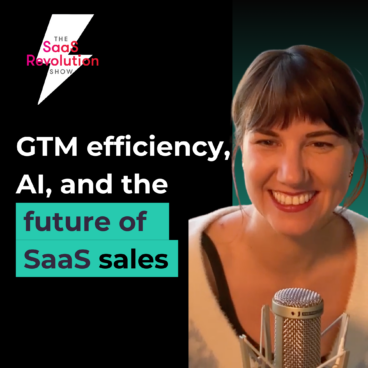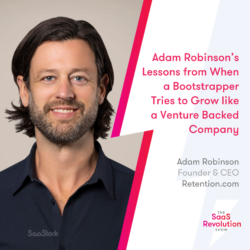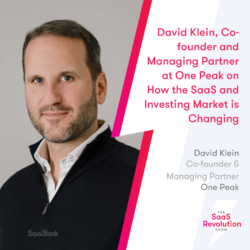In this episode of The SaaS Revolution Show, host Alex Theuma is joined by Go Nimbly CEO (and SaaStock USA Speaker) Jen Igartua.
“This is a silly way of saying it but we’re getting back to selling on the golf course. We’re getting back to in-person, people want to be having meaningful interactions with the people that they’re buying from, and it’s becoming a much more strategic sale, even at low ACV values.”
It’s an episode packed with practical advice to help turn your go-to-market strategy from a cost centre into an efficient, revenue-generating machine, including:
- Why GTM efficiency is now critical for SaaS growth.
- How AI and automation are transforming sales workflows.
- The biggest mistakes SaaS companies make with their tech stack.
- The tools that top RevOps leaders are using to drive revenue.
- Why high-touch, relationship-driven selling is making a comeback.
- What’s next for Go Nimbly, including the upcoming RevFest event.
Watch (or listen) below or read on for key takeaways.
Listen to the audio:
Why GTM efficiency is more important than ever
The days of growth at all costs are well behind us, causing two shifts that impact how go-to-market teams operate:
- Buying is harder: There’s more competition for attention and customers expect a unique experience.
- Capital has become more expensive and companies are under increasing pressure to grow more efficiently.
For GTM teams, this moves the focus from doing more to doing better.
Identifying GTM efficiency opportunities
The goal for GTM efficiency is often automation. To find your biggest automation opportunities, Jen advises shadowing your reps–from your most tenured to your newest team member.
“The easiest way is to go and sit with your reps. I don’t care if you’ve got three or 30, just go create half an hour. Just to understand, do you even have a process? You might think you do and then find everybody’s doing it differently.”
When you’re with your reps, look for parts of the process that are particularly manual or time consuming. Opportunities ripe for automation include:
- Prospecting and pre-meeting research: Tools like Clay can gather a prospect’s LinkedIn activity, recent company news, and even relevant industry insights in seconds.
- Post-meeting AI summaries: Integrations with Gong or similar tools can generate instant summaries of key discussion points, saving reps from manual note-taking.
- Lead scoring and prioritisation: AI-driven scoring models can help reps focus on the leads most likely to convert.
The tools driving GTM efficiency in 2025
“In 2020 and 2021, we bought every tool under the sun and it sat as shelfware. Now, teams want fewer tools—but the right ones.”
A few years ago, GTM teams had complex tech stacks made of specialised tools. These stacks relied on partner integrations and required teams to adopt and maintain multiple platforms effectively.
Now, as teams focus on efficiency, both buyers and sellers are looking at consolidation:
- Platforms like Gong now offer overlapping features with competitors Clari and Outreach, reducing the need for multiple standalone solutions.
- Instead of purchasing multiple data enrichment tools, many teams are building their own internal solutions using automation platforms.
Perhaps the most talked about right now is Clay. As Jen put it:
“Clay isn’t just a tool—it’s an entire system that lets RevOps teams build their own automations without code.”
For example, users can use it to:
- Pull LinkedIn insights, company funding history, and social media activity in real-time.
- Enrich CRM data with automated workflows that require zero manual input.
- Integrate seamlessly with outbound email sequences to create hyper-personalised outreach at scale.
Other tools Jen identified include:
- Pocus: A PLG-focused lead scoring tool that helps sales teams identify the best product-qualified leads (PQLs).
- Gong AI workflows: Automates deal tracking and conversation analysis to surface hidden sales insights.
- Apollo & ZoomInfo: Major players in data enrichment, though increasingly competing with more automated solutions.
The power of personalisation and relationship-driven selling
While a key goal, GTM efficiency isn’t only about automation—it’s about making every interaction count. Buyers are more selective than ever, and they crave human, meaningful connections with the people they buy from.
In practice, this means:
- Reps are shifting away from mass email campaigns and leaning into high-touch sales strategies like in-person meetings and curated events.
- Using AI to tailor outreach and achieve personalisation at scale.
- Doubling down on brand trust and authority, thought leadership, and community-building.
The future of SaaS GTM
Looking ahead, SaaS leaders who embrace efficiency will have a significant competitive advantage. But will companies that ignore these trends get left behind? Not necessarily, according to Jen, some SaaS unicorns continue to scale despite messy operations.
However, for the vast majority of companies, maximising efficiency is the fastest path to profitable growth:
“I’ve worked with companies that have grown in spite of their operations. But if you want to be the next unicorn, GTM efficiency is key.”
Hear more from Jen at SaaStock USA (13-14 May)
If you want to dive deeper into GTM efficiency, Jen is hosting a roundtable on AI tools that really move the needle at our GTM Forum in Austin.
The GTM Forum is where you’ll sharpen your playbook, connect with top revenue, marketing, and customer success leaders, and get the strategies to build pipeline, speak your customer’s language, and drive real growth. Don’t let the market dictate your GTM success – take control and win.
Tickets are selling fast. Get yours today.






